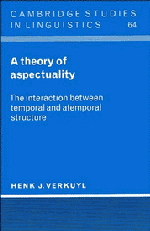PART II - NOUN PHRASE STRUCTURE
Published online by Cambridge University Press: 05 July 2011
Summary
INTRODUCTION TO PART II
In this second part, one of the central issues will be the question of whether or not the intuitive notion of Specified Quantity of A ([+sqa]) can be captured by the Theory of Generalized Quantification. As it is possible to circumscribe this notion quite precisely at the informal level, it should be possible to give it a formal interpretation in terms of existing or new notions of this theory, where it may serve its purpose as explaining part of the compositional machinery involved in the interpretation of sentences expressing terminative aspect. The same applies mutatis mutandis to the notion of Unspecified Quantity ([-sqa]).
It may be helpful to begin the search for a formal articulation of the notion of (Un-) Specified Quantity of A by having a closer look at its informal characterization in Verkuyl (1972):
The node specified calls for some further explanation. Nodes like finite or bounded would come close to the meaning of specified; however, unspecified cannot be identified with infinite. The category specified could be characterized as ‘giving the bounds of the temporal interval in question’; the category unspecified as ‘not giving the bounds of the temporal interval in question’. Since the expression ‘giving the bounds of an interval’ involves referential information, specified is provisionally located in the Determiner. The point is that het concert (the concerto) and een concert (a concerto,), when occurring in sentences like De Machula speelde het celloconcert van Schumann (De Machula played Schumann's cello concetto) refer to bounded or finite intervals on the Time axis. […]
Information
- Type
- Chapter
- Information
- A Theory of AspectualityThe Interaction between Temporal and Atemporal Structure, pp. 69 - 76Publisher: Cambridge University PressPrint publication year: 1993
